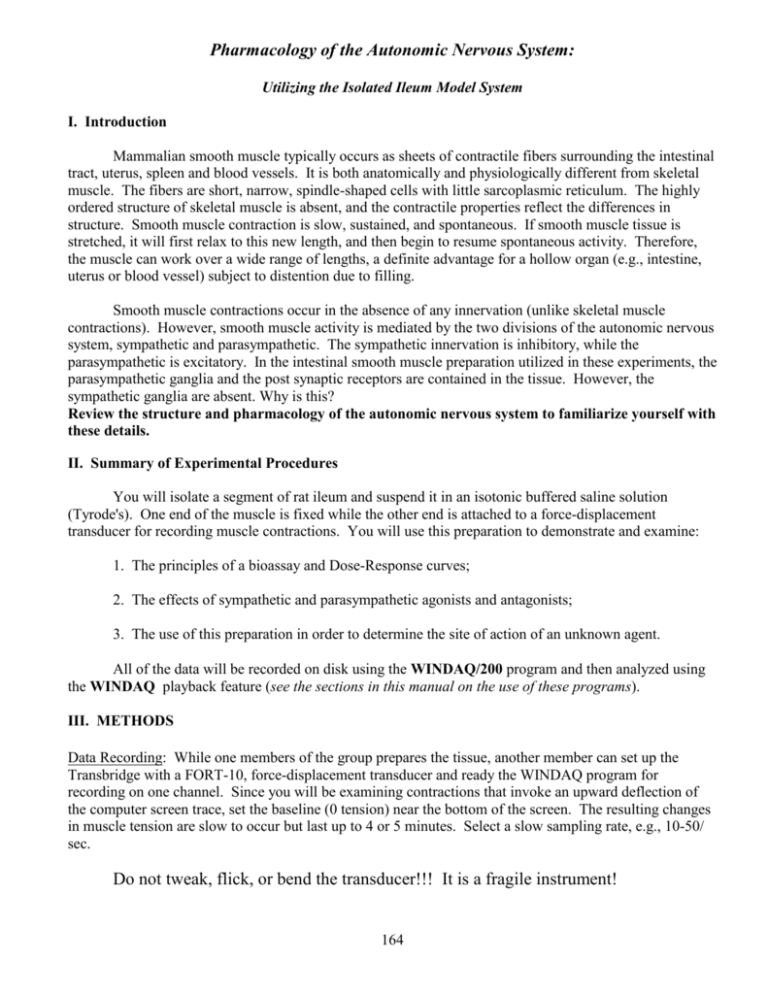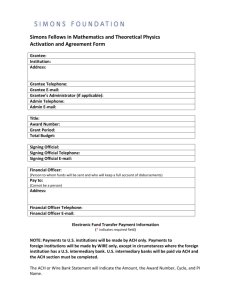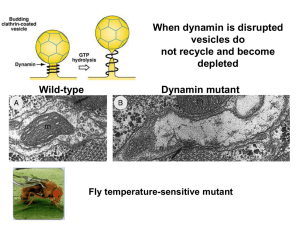muscle dosage
advertisement

Pharmacology of the Autonomic Nervous System: Utilizing the Isolated Ileum Model System I. Introduction Mammalian smooth muscle typically occurs as sheets of contractile fibers surrounding the intestinal tract, uterus, spleen and blood vessels. It is both anatomically and physiologically different from skeletal muscle. The fibers are short, narrow, spindle-shaped cells with little sarcoplasmic reticulum. The highly ordered structure of skeletal muscle is absent, and the contractile properties reflect the differences in structure. Smooth muscle contraction is slow, sustained, and spontaneous. If smooth muscle tissue is stretched, it will first relax to this new length, and then begin to resume spontaneous activity. Therefore, the muscle can work over a wide range of lengths, a definite advantage for a hollow organ (e.g., intestine, uterus or blood vessel) subject to distention due to filling. Smooth muscle contractions occur in the absence of any innervation (unlike skeletal muscle contractions). However, smooth muscle activity is mediated by the two divisions of the autonomic nervous system, sympathetic and parasympathetic. The sympathetic innervation is inhibitory, while the parasympathetic is excitatory. In the intestinal smooth muscle preparation utilized in these experiments, the parasympathetic ganglia and the post synaptic receptors are contained in the tissue. However, the sympathetic ganglia are absent. Why is this? Review the structure and pharmacology of the autonomic nervous system to familiarize yourself with these details. II. Summary of Experimental Procedures You will isolate a segment of rat ileum and suspend it in an isotonic buffered saline solution (Tyrode's). One end of the muscle is fixed while the other end is attached to a force-displacement transducer for recording muscle contractions. You will use this preparation to demonstrate and examine: 1. The principles of a bioassay and Dose-Response curves; 2. The effects of sympathetic and parasympathetic agonists and antagonists; 3. The use of this preparation in order to determine the site of action of an unknown agent. All of the data will be recorded on disk using the WINDAQ/200 program and then analyzed using the WINDAQ playback feature (see the sections in this manual on the use of these programs). III. METHODS Data Recording: While one members of the group prepares the tissue, another member can set up the Transbridge with a FORT-10, force-displacement transducer and ready the WINDAQ program for recording on one channel. Since you will be examining contractions that invoke an upward deflection of the computer screen trace, set the baseline (0 tension) near the bottom of the screen. The resulting changes in muscle tension are slow to occur but last up to 4 or 5 minutes. Select a slow sampling rate, e.g., 10-50/ sec. Do not tweak, flick, or bend the transducer!!! It is a fragile instrument! 164 Dissection Techniques: Your TA will mercifully dispatch the rat with CO2 narcosis. After the animal stops breathing, make an abdominal midline incision to expose the viscera. Take care to avoid cutting any visceral organs. Expose the viscera and cut the diaphragm at the top of the abdominal cavity. Note any spontaneous movements of the intestine in situ. Carefully lift out the intestine without stretching it and lay it in a Petri dish containing Tyrode's solution warmed to room temperature. Locate a segment of the small intestine as close to the ileo-cecal junction as possible and cut away the mesentery beginning at this point and proceeding for 10 - 15 cm toward the stomach. Handle the intestine gently and keep it moist. (Feel free to perform a dissection of the rat. Your TA will point out the major organs.) Sever the ileum as close to the colon as possible and again about 12 -15 cm toward the mouth. Place this isolated section into a separate Petri dish containing fresh Tyrode's solution. Flush and rinse out the lumen by gently forcing Tyrode's through it with a 5 ml syringe. Place this rinsed section of intestine into another Petri dish containing fresh Tyrode's solution. Do not let it touch or sit in fluid containing the intestinal contents. Attach surgical thread to one end of the ileum. One end of this thread should be left about 10-12 inches long (see Figs 1 & 2). Be sure to tie square knots; no granny knots, please! A second thread should be tied about 2.0 - 3.0 cm down the ileum from the first thread. The ends of this second thread should be formed into a small loop with another square knot (Figs. 1 & 2). Carefully isolate this segment of ileum by cutting it outside of the attached ligatures. Repeat this procedure on the remaining length of ileum until one segment has been prepared for each lab group. Figure 1 illustrates a resulting section of ileum. Attach one end of your segment to the hook in the bottom of the tissue bath ( see Fig. 2 & 3) using the small loop in the thread. Attach the long thread attached to the other end of the muscle to the lever of the transducer. Tie the ileum FIRST!!!! Then, move the transducer up in order to place a very small amount of tension on the ileum segment. Watch the screen in order to determine when you start to place tension on the transducer. Be careful not to damage the transducer!!! Fill the bath with a Tyrode's solution by clamping the tubing at the base of the tissue bath and adding Tyrode’s to the top. 165 166 Check the setup to make certain that the suture is as vertical as possible and is not touching the side of the tissue bath and the muscle has a slight tension on it. Very gently, start aerating the solution using the attached air pump and record the contractions using the WINDAQ data acquisition program. The sampling rate should be set at a low frequency. After suspending the muscle but before adding any drugs, calibrate the transducer with a 10 g weight. You will probably also need to turn the gain down on the transbridge amplifier, probably to x100 or even x10 in order to observe full contraction of the ileum segment. IV. EXPERIMENTS A. Bioassay for Acetylcholine (ACh) ACh interacts with post synaptic cholinergic receptors on the ileum to initiate and potentiate contractions. Remember that the most peripheral receptors are affected first. (So, are these nicotinic or muscarinic?) The magnitude of the resulting contraction is proportional to the dose of ACh applied within a restricted range of ACh concentrations which varies from muscle to muscle. You will take advantage of this to construct a Dose-Response curve and then use this standard curve (see Bsci 105 and Bsci 230 lab manuals!) to determine the [ACh] of an "unknown" solution. 167 Stock ACh solution will be available at a concentration of 1 x 10-1 M (100 mM). Make a serial dilution of this solution by placing 0.5 ml of the stock ACh in 4.5 ml of Tyrode's solution; this is equivalent to a 10-fold dilution of the stock ACh that yields a 10-2 M ACh solution. Take a 0.5 ml of this 10-2 M solution and add 4.5 ml of Tyrode and you will now have a 10-3 M solution of ACh. Continue this until you have ACh solutions ranging from 10-2 M to 10-7 M. Note that these dilutions provide a range over which you can test the ileum's response. You can make other ACh dilutions within a more narrow range once you have determined how your particular ileum responds. You will want to use at least 8 different [Ach] in order to get a complete picture of your dose-response curve. Where should these 8 [Ach] lie along the x-axis? That is which concentrations will provide the most information about the shape of your doseresponse curve? Do you understand log doses and dilutions??? To be sure, complete the following calculations before going any further. Remember that you can use the formula C1 x V1 = C2 x V2, (C = concentration, V= volume). The trick is in determining how to assign the variables. Your TA will elaborate. 1. If you dilute 1.0 ml of a 10-5M ACh solution with 1.0 ml of Tyrode's buffer, the [ACh] now = __________________________________. 2. After adding 0.2 ml of 10-4M ACh to 20 ml of Tyrode's buffer, the [ACh] now = _____________________________________. 3. After adding another 0.2 ml of 10-4M ACh to the same 20 ml of Tyrode's buffer in #2 above, the [ACh] now = _____________________________________. 4. If you add 0.4 ml of an ACh stock solution to 20 ml of Tyrode's and found that you now have a final [ACh] of 2 x 10-6M in Tyrode's, what was the [ACh] in the original stock solution? ____________________________________________. But, we haven't yet considered the fact that the dose of Ach gets "diluted" when it is added to the volume of liquid in the tissue bath. For example if you add the following aliquots, what is the final [ACh] in the bath if the initial bath volume is 20 ml? 0.2 ml of 0.2 ml of 0.2 ml of 0.2 ml of 10-6 M ACh giving a [ACh]bath = ___________M 10-5 M ACh giving a [ACh]bath = ___________M 10-4 M ACh giving a [ACh]bath = ___________M 10-3 M ACh giving a [ACh]bath = ___________M After constructing your protocol (stock doses, volumes to be added, and resulting bath concentrations): 1. Start recording the data in the computer and quickly add the first sample (lowest dose) of ACh, waiting approximately 1 min. for a response. Wait approximately 1 full min before assuming no response. Once you witness a contraction, you have a very rough estimate of the log unit threshold dose of ACh for this section of this particular ileum. Plan your protocol of ACh additions to include several (>8) doses of ACh that are between threshold and maximum. 2. Add the next volume increment, without flushing the bath. 168 3. Once a contraction is evoked, the timing of your next addition becomes critical. As soon as this initial contraction reaches a maximum and the trace begins to plateau, add the next dose. A series of doses can then be added to the muscle, without flushing out the organ bath between each addition. This method is based on the relatively slow response and recovery time of the smooth muscle. By the time the muscle has reached maximal contraction, the added ACh has essentially equilibrated among the accessible tissue compartments. At this point, the muscle is in a state of contraction proportional to the concentration of exogenous ACh. Therefore, if the next dose of ACh is then added (at the plateau point of the proceeding dose), the muscle will contract to a length proportional to the total dose now in the bath. How can you determine the TOTAL [ACh] in the bath at each step? (HINT: must consider total AMOUNT of ACh added and then calculate the total volume of liquid in the bath at each step.) In order to determine the final [ACh] in the tissue bath, you will have to add the doses of ACh (in moles), beginning with the most dilute solution, as well as consider the incremental increase in bath volume with each added 0.2 ml dose. 4. Now graph your results on semi-log graph paper. Simply place your doses of ACh on the X axis (the logarithmic axis) and the corresponding muscle responses (in grams of tension) on the Y axis (linear axis). Why is it often necessary to plot the dose on a logarithmic scale? B. *ACh Antagonist* 1. 2. antagonist. C. Obtain a representative ACh dose-response (D/R) curve. Duplicate the curve in the presence of 10-7 M (bath dose!) atropine, a muscarinic Plot the curves obtained in A & B on the same axes. 3. Predict what will happen if the dose of the antagonist was increased or decreased. 4. Predict what will happen if the ACh D/R curve were generated in the presence of hexamethonium. (After C, try it!!!!) Inhibition of Acetylcholinesterase (AChase) AChesterase is an enzyme located on cholinergic post synaptic membranes. AChesterase hydrolyzes ACh into choline and acetate which do not interact with the ACh receptors. Demonstrate the effect of an AChase inhibitor, eserine (10-6 - 10-7 M), on the ileum's response to ACh. Report your results as dose-response curves for A, B & C plotted on the same axes. D. (WEEK 2) Determining the Site of Action of an Unknown Agent You will be given a solution containing an unknown agent. You must use the ileum preparation to determine its site of action. The agent may be any one of the following: muscarinic agonist or antagonist nicotinic agonist or antagonist alpha adrenergic agonist or antagonist beta adrenergic agonist or antagonist nonspecific muscle contraction or relaxing agent 169 Before you arrive in lab for week 2, construct a flow chart of all possible results induced by an unknown agent. Thus, the drug may elicit contraction, relaxation, or no response. If it induces contraction of the ileum, what are the possibilities? It could be a muscarinic agonist or a nicotinic agonist. What drugs or sequence of drugs would you apply to distinguish among these possibilities? Consider this scenario: if the unknown was blocked by atropine but not by hexamethonium, what would your conclusion be? What if it weren't blocked by either? Now construct a flow chart for determining the identity of an unknown agent that produces ileum relaxation….no response… Suggested Strategy: 1. Test muscle with ACh to determine tissue viability. Wash thoroughly. 2. Apply unknown. 3. Employ your flow chart of possible results and the isolated ileum preparation to actually determine the site of action of an unknown drug. Note that you may need to apply a small dose of Ach in order to generate some tension before you are actually able to see any relaxation elicited by an adrenergic agonist. 170






